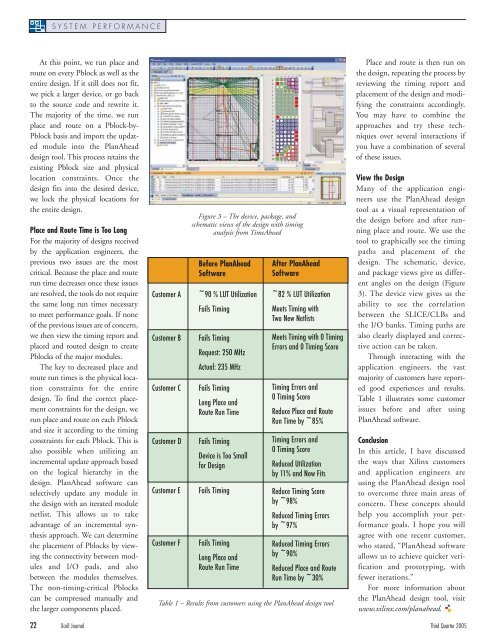Design Challenges: Avoiding the Pitfalls, winning the game - Xilinx
Design Challenges: Avoiding the Pitfalls, winning the game - Xilinx
Design Challenges: Avoiding the Pitfalls, winning the game - Xilinx
You also want an ePaper? Increase the reach of your titles
YUMPU automatically turns print PDFs into web optimized ePapers that Google loves.
SYSTEM PERFORMANCE<br />
At this point, we run place and<br />
route on every Pblock as well as <strong>the</strong><br />
entire design. If it still does not fit,<br />
we pick a larger device, or go back<br />
to <strong>the</strong> source code and rewrite it.<br />
The majority of <strong>the</strong> time, we run<br />
place and route on a Pblock-by-<br />
Pblock basis and import <strong>the</strong> updated<br />
module into <strong>the</strong> PlanAhead<br />
design tool. This process retains <strong>the</strong><br />
existing Pblock size and physical<br />
location constraints. Once <strong>the</strong><br />
design fits into <strong>the</strong> desired device,<br />
we lock <strong>the</strong> physical locations for<br />
<strong>the</strong> entire design.<br />
Place and Route Time is Too Long<br />
For <strong>the</strong> majority of designs received<br />
by <strong>the</strong> application engineers, <strong>the</strong><br />
previous two issues are <strong>the</strong> most<br />
critical. Because <strong>the</strong> place and route<br />
run time decreases once <strong>the</strong>se issues<br />
are resolved, <strong>the</strong> tools do not require<br />
<strong>the</strong> same long run times necessary<br />
to meet performance goals. If none<br />
of <strong>the</strong> previous issues are of concern,<br />
we <strong>the</strong>n view <strong>the</strong> timing report and<br />
placed and routed design to create<br />
Pblocks of <strong>the</strong> major modules.<br />
The key to decreased place and<br />
route run times is <strong>the</strong> physical location<br />
constraints for <strong>the</strong> entire<br />
design. To find <strong>the</strong> correct placement<br />
constraints for <strong>the</strong> design, we<br />
run place and route on each Pblock<br />
and size it according to <strong>the</strong> timing<br />
constraints for each Pblock. This is<br />
also possible when utilizing an<br />
incremental update approach based<br />
on <strong>the</strong> logical hierarchy in <strong>the</strong><br />
design. PlanAhead software can<br />
selectively update any module in<br />
<strong>the</strong> design with an iterated module<br />
netlist. This allows us to take<br />
advantage of an incremental syn<strong>the</strong>sis<br />
approach. We can determine<br />
<strong>the</strong> placement of Pblocks by viewing<br />
<strong>the</strong> connectivity between modules<br />
and I/O pads, and also<br />
between <strong>the</strong> modules <strong>the</strong>mselves.<br />
The non-timing-critical Pblocks<br />
can be compressed manually and<br />
<strong>the</strong> larger components placed.<br />
Figure 3 – The device, package, and<br />
schematic views of <strong>the</strong> design with timing<br />
analysis from TimeAhead<br />
Before PlanAhead<br />
Software<br />
Customer A ~90 % LUT Utilization<br />
Fails Timing<br />
Customer B Fails Timing<br />
Request: 250 MHz<br />
Actual: 235 MHz<br />
Customer C Fails Timing<br />
Long Place and<br />
Route Run Time<br />
Customer D Fails Timing<br />
Device is Too Small<br />
for <strong>Design</strong><br />
Customer E Fails Timing<br />
Customer F Fails Timing<br />
Long Place and<br />
Route Run Time<br />
After PlanAhead<br />
Software<br />
~82 % LUT Utilization<br />
Meets Timing with<br />
Two New Netlists<br />
Meets Timing with 0 Timing<br />
Errors and 0 Timing Score<br />
Timing Errors and<br />
0 Timing Score<br />
Reduce Place and Route<br />
Run Time by ~85%<br />
Timing Errors and<br />
0 Timing Score<br />
Reduced Utilization<br />
by 11% and Now Fits<br />
Reduce Timing Score<br />
by ~98%<br />
Reduced Timing Errors<br />
by ~97%<br />
Reduced Timing Errors<br />
by ~90%<br />
Reduced Place and Route<br />
Run Time by ~30%<br />
Table 1 – Results from customers using <strong>the</strong> PlanAhead design tool<br />
Place and route is <strong>the</strong>n run on<br />
<strong>the</strong> design, repeating <strong>the</strong> process by<br />
reviewing <strong>the</strong> timing report and<br />
placement of <strong>the</strong> design and modifying<br />
<strong>the</strong> constraints accordingly.<br />
You may have to combine <strong>the</strong><br />
approaches and try <strong>the</strong>se techniques<br />
over several interactions if<br />
you have a combination of several<br />
of <strong>the</strong>se issues.<br />
View <strong>the</strong> <strong>Design</strong><br />
Many of <strong>the</strong> application engineers<br />
use <strong>the</strong> PlanAhead design<br />
tool as a visual representation of<br />
<strong>the</strong> design before and after running<br />
place and route. We use <strong>the</strong><br />
tool to graphically see <strong>the</strong> timing<br />
paths and placement of <strong>the</strong><br />
design. The schematic, device,<br />
and package views give us different<br />
angles on <strong>the</strong> design (Figure<br />
3). The device view gives us <strong>the</strong><br />
ability to see <strong>the</strong> correlation<br />
between <strong>the</strong> SLICE/CLBs and<br />
<strong>the</strong> I/O banks. Timing paths are<br />
also clearly displayed and corrective<br />
action can be taken.<br />
Through interacting with <strong>the</strong><br />
application engineers, <strong>the</strong> vast<br />
majority of customers have reported<br />
good experiences and results.<br />
Table 1 illustrates some customer<br />
issues before and after using<br />
PlanAhead software.<br />
Conclusion<br />
In this article, I have discussed<br />
<strong>the</strong> ways that <strong>Xilinx</strong> customers<br />
and application engineers are<br />
using <strong>the</strong> PlanAhead design tool<br />
to overcome three main areas of<br />
concern. These concepts should<br />
help you accomplish your performance<br />
goals. I hope you will<br />
agree with one recent customer,<br />
who stated, “PlanAhead software<br />
allows us to achieve quicker verification<br />
and prototyping, with<br />
fewer iterations.”<br />
For more information about<br />
<strong>the</strong> PlanAhead design tool, visit<br />
www.xilinx.com/planahead.<br />
22 Xcell Journal Third Quarter 2005

















